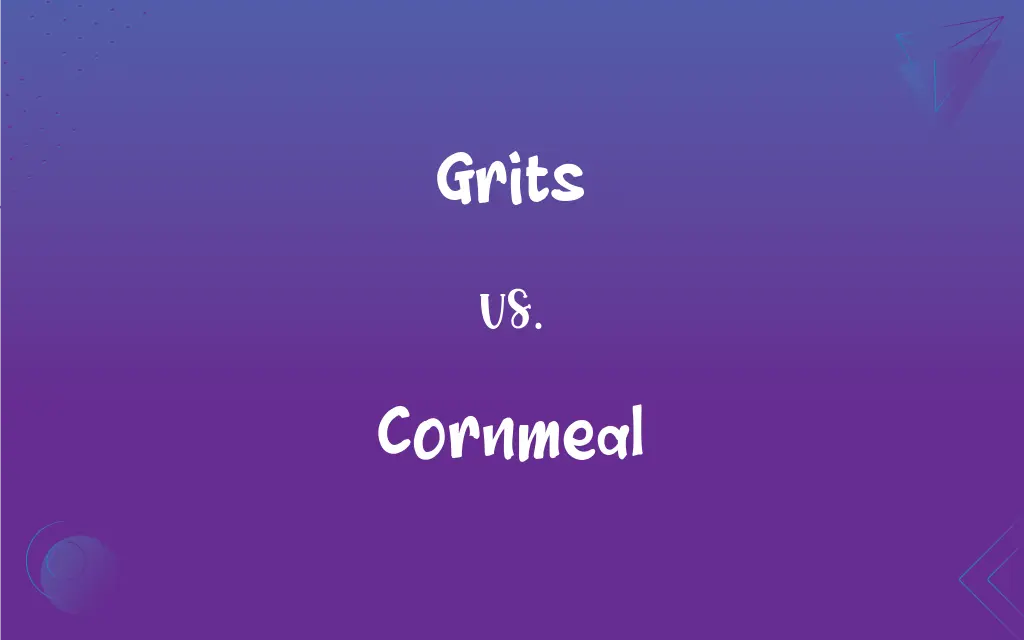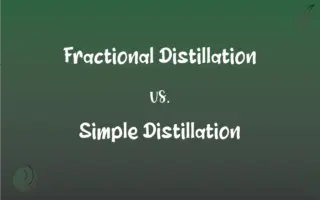Grits vs. Cornmeal: What's the Difference?
Edited by Aimie Carlson || By Harlon Moss || Updated on October 20, 2023
Grits are coarsely ground, dried corn, often boiled for consumption; cornmeal is finely ground corn, used in baking and cooking.

Key Differences
Grits and cornmeal are both products derived from corn, but they differ in their texture and usage. Grits are made from dried corn (often white or yellow) that has been coarsely ground. They are a staple in Southern cuisine and are commonly served as a side dish, especially at breakfast. Cornmeal, on the other hand, is more finely ground than grits and can be either white or yellow.
Though both grits and cornmeal come from corn, the process for making them is distinct. Grits are typically made from hominy, which is corn that has been treated with an alkali to remove the hull. After this, the dried hominy is ground to produce grits. Cornmeal, in contrast, is made from ground, untreated dried corn. Its fine texture makes it suitable for a variety of culinary applications.
In terms of culinary applications, grits and cornmeal have their unique roles. Grits are commonly boiled with water or milk and served with a variety of toppings ranging from cheese to shrimp. They're a staple in dishes like shrimp and grits. Cornmeal, due to its fine texture, is often used in baking, especially in bread, muffins, and tortillas. It can also be used as a breading for fried foods.
Nutritionally, both grits and cornmeal offer similar benefits since they originate from corn. They are good sources of fiber, vitamins, and minerals. However, because grits are often made from hominy, they might have a different nutrient profile, especially in terms of niacin content, than cornmeal.
Comparison Chart
Texture
Coarse
Fine
ADVERTISEMENT
Origins
Often from hominy (alkali-treated corn)
From untreated dried corn
Common Uses
Boiled and served as a dish
Baking, breading, cooking
Cuisine
Staple in Southern cuisine
Used widely in various cuisines
Nutritional Differences
Might differ due to alkali treatment (e.g., higher niacin)
Standard corn nutritional profile
Grits and Cornmeal Definitions
Grits
Coarsely ground corn, often from hominy.
She enjoyed her morning bowl of grits with butter and cheese.
ADVERTISEMENT
Cornmeal
Finely ground corn used in cooking and baking.
She used cornmeal to make the cornbread for dinner.
Grits
A versatile side dish, suitable for various meals.
For dinner, they served grilled chicken alongside creamy grits.
Cornmeal
Available in white or yellow variants.
She prefers using yellow cornmeal for its rich color.
Grits
A staple in Southern American cuisine.
When visiting the South, trying shrimp and grits is a must.
Cornmeal
Essential for recipes like muffins, bread, and tortillas.
The recipe called for two cups of cornmeal.
Grits
Consumed as a hot dish after boiling.
He prepared the grits by boiling them with a pinch of salt.
Cornmeal
Has a slightly gritty texture ideal for certain dishes.
The cornmeal added a nice texture to the pancakes.
Grits
Often paired with savory toppings or mix-ins.
Cheesy grits are her absolute favorite comfort food.
Cornmeal
Commonly utilized as breading for fried foods.
He coated the fish in cornmeal before frying it.
Grits
Plural of grit('hulled oats')
Cornmeal
Meal made from corn, used in a wide variety of foods. Also called Indian meal.
Grits
(Western Hemisphere) Coarsely ground hominy which is boiled and eaten, primarily in the Southern United States.
Cornmeal
Dried corn (maize) milled (ground) to a coarse meal.
She made a kind of polenta from cornmeal and chicken broth, with some cheese sprinkled on top.
Grits
Plural of grit
Cornmeal
Coarsely ground corn
Grits
Coarsely ground hulled corn boiled as a breakfast dish in the southern United States
FAQs
Is polenta the same as grits?
While similar, polenta is made from yellow corn, while grits are often from white corn.
Can I make my own cornmeal at home?
Yes, by grinding dried corn kernels to a fine consistency.
Why is cornmeal used in baking?
Its fine texture makes it suitable for bread, muffins, and other baked goods.
Are grits and cornmeal interchangeable in recipes?
No, due to texture differences, they often serve different culinary purposes.
Can I make a pizza crust with cornmeal?
Yes, cornmeal can make a crunchy, gluten-free pizza crust.
Can I use cornmeal as a thickening agent?
Yes, cornmeal can thicken soups, stews, and sauces.
How do I make cornmeal pancakes?
Mix cornmeal with other pancake ingredients like flour, eggs, and milk, and then cook on a griddle.
Which is coarser, grits or cornmeal?
Grits are coarser than cornmeal.
What is the difference between white and yellow grits?
The color difference stems from the type of corn used; flavor differences are minimal.
How can I flavor my grits?
Add cheeses, herbs, spices, or proteins like shrimp and bacon.
What's the shelf life of cornmeal?
Stored in a cool, dry place, it lasts for about a year.
Are instant grits nutritionally different from regular grits?
Instant grits may have added preservatives and flavorings, affecting their nutritional profile.
Are grits a good source of energy for breakfast?
Yes, grits are carbohydrate-rich, providing energy for the start of the day.
Can I use cornmeal in desserts?
Absolutely! Cornmeal can be used in desserts like cookies, cakes, and puddings.
Are there nutritional benefits to consuming grits?
Yes, grits are a source of fiber, vitamins, and minerals.
How should I store leftover cooked grits?
Refrigerate in an airtight container and consume within a few days.
Is cornmeal gluten-free?
Yes, cornmeal is naturally gluten-free, but check for cross-contamination.
Why are my grits lumpy?
Lumps can form if grits are added to boiling water too quickly or not stirred enough.
Can you eat grits cold?
While traditionally served hot, cold grits can be consumed, especially in dishes like grit cakes.
What can I substitute for cornmeal in a recipe?
Ground polenta or masa harina can be substitutes, but they may alter the dish's texture.
About Author
Written by
Harlon MossHarlon is a seasoned quality moderator and accomplished content writer for Difference Wiki. An alumnus of the prestigious University of California, he earned his degree in Computer Science. Leveraging his academic background, Harlon brings a meticulous and informed perspective to his work, ensuring content accuracy and excellence.
Edited by
Aimie CarlsonAimie Carlson, holding a master's degree in English literature, is a fervent English language enthusiast. She lends her writing talents to Difference Wiki, a prominent website that specializes in comparisons, offering readers insightful analyses that both captivate and inform.
































































